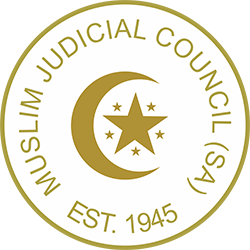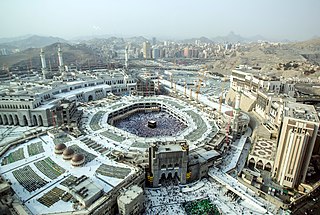
Imam is an Islamic leadership position. For Sunni Muslims, Imam is most commonly used as the title of a prayer leader of a mosque. In this context, imams may lead Islamic prayers, serve as community leaders, and provide religious guidance. Thus for Sunnis, anyone can study the basic Islamic sciences and become an Imam.

Cape Malays also known as Cape Muslims or Malays, are a Muslim community or ethnic group in South Africa. They are the descendants of enslaved and free Muslims from different parts of the world, specifically Indonesia and other Asian countries, who lived at the Cape during Dutch and British rule.

A dargah is a shrine or tomb built over the grave of a revered religious figure, often a Sufi saint or dervish. Sufis often visit the shrine for ziyarat, a term associated with religious visitation and pilgrimages. Dargahs are often associated with Sufi eating and meeting rooms and hostels, called khanqah or hospices. They usually include a mosque, meeting rooms, Islamic religious schools (madrassas), residences for a teacher or caretaker, hospitals, and other buildings for community purposes.

In Islam, Friday prayer, or Congregational prayer is a community prayer service held once a week on Fridays. All Muslim men are expected to participate at a mosque with certain exceptions due to distance and situation. Women and children can also participate but do not fall under the same obligation that men do. The service consists of several parts including ritual washing, chants, recitation of scripture and prayer, and sermons.

South Africa is a Christian majority nation with Islam being a minority religion, practised by roughly 1.6% of the total population. Islam in South Africa has grown in three different phases. The first phase brought the earliest Muslims as part of the involuntary migration of slaves, artisans, political prisoners, and political exiles from the Dutch East Indies to the Cape Colony from 1652 to 1800. The second phase was the arrival of indentured labourers from British India to work in the sugar-cane fields in Natal from 1860 to 1911. Of the approximately 176,000 Indians of all faiths who were transported to the Natal province, almost 7–10% of the first shipment were Muslims.
There is a difference of opinion among Muslims regarding the circumstances in which women may act as imams, i.e. to lead a mixed gendered congregation in salat (prayer). The orthodox position is that women cannot lead men in prayer, which is justified by various Quranic verses and Hadith about the roles and responsibilities of men and women.

The Bo-Kaap is an area of Cape Town, South Africa formerly known as the Malay Quarter. It is a former racially segregated area, situated on the slopes of Signal Hill above the city centre and is a historical centre of Cape Malay culture in Cape Town. The Nurul Islam Mosque, established in 1844, is located in the area.

Sheikh Abu Bakr Effendi, also spelt Ebu Bekir Efendi, was an Ottoman qadi sent in 1862 by Sultan Abdulaziz at the request of Queen Victoria to the Cape of Good Hope, in order to teach and assist the Muslim community of the Cape Malays. He is known for having made several major contributions to Islam in South Africa, including the translation of his 1877 work, Bayân al-Dîn, into the Afrikaans language, then in a very early stage of development. He is credited with introducing the fez as headwear for male Muslims in the Cape, and his presence had a significant impact on the expansion and consolidation of Islam at the Dutch Cape Colony.

The holiest sites in Islam are located in the Arabian Peninsula. While the significance of most places typically varies depending on the Islamic sect, there is a consensus across all mainstream branches of the religion that affirms two cities as having the highest degree of holiness, in descending order: Mecca, and Medina. Mecca's Al-Masjid al-Haram, Al-Masjid an-Nabawi in Medina are all revered by Muslims as sites of great importance.

The Nurul Islam Mosque is a Sunni Islam mosque in the Bo-Kaap area of Cape Town, South Africa. When it was founded in 1844, the structure could hold 150 worshipers. Renovated in 2001, it can now hold 700 worshipers.

The Muslim Judicial Council SA (MJC), a non-profit umbrella body of Sunni Islamic clerics in South Africa, is headquartered in Cape Town, South Africa. It was established in 1945 by the Muslim Progressive Society. As of 2009, approximately 150 mosques were affiliated with it.

The Palm Tree Mosque, or the Church of Jan van Bougies, or the Dadelboom Mosque, is a former residence and current mosque in Long Street, Cape Town, South Africa. It is the oldest substantially unaltered building in Long Street.

Masjid al-Haram, also known as the Sacred Mosque or the Great Mosque of Mecca, is considered to be the most significant mosque in Islam. It encloses the vicinity of the Kaaba in Mecca, in the Mecca Province of Saudi Arabia. It is among the pilgrimage sites associated with the Hajj, which every Muslim must perform at least once in their lives if able. It is also the main site for the performance of ʿUmrah, the lesser pilgrimage that can be undertaken any time of the year. The rites of both pilgrimages include circumambulating the Kaaba within the mosque. The Great Mosque includes other important significant sites, such as the Black Stone, the Zamzam Well, Maqam Ibrahim, and the hills of Safa and Marwa.

The Tana Baru Cemetery is a Muslim cemetery where some of the earliest and respected Muslim settlers of South Africa were buried. The cemetery is located in Bo-kaap, Cape Town.

Salat al-jama‘ah or prayer in congregation (jama'ah) is considered to have more social and spiritual benefit than praying by oneself. When praying in congregation, the people stand in straight parallel rows behind the chosen imam, facing qibla. The imam, who leads the congregation in salat, is usually chosen to be a scholar or the one who has the best knowledge of the Qur'an, preferably someone who has memorised it in its entirety. In the first row behind the Imam, if available, would be another hafiz to correct the Imam in case a mistake is made during the performance of the salat. The prayer is performed as normal, with the congregation following the actions and movements of the imam as he performs the salat.

Faldela Williams was a South African cook and cookbook writer whose books inspired generations of cooks after her to preserve the culinary heritage of South Africa's Cape Malay people.

The Queen Victoria Mosque, also called the Jamia Mosque, is a mosque, situated at the corner of Chiappini and Castle street, in Cape Town, South Africa. It is considered to be the first and oldest mosque in Cape Town, and the largest in the Bo-Kaap area of Cape Town. The mosque is a National heritage site.

Gassan Solomon was a South African politician and Muslim religious leader in Cape Town. He represented the African National Congress (ANC) in the National Assembly from 1994 to 2009.

Islam in Washington, D.C. is the third largest religion, after Christianity and Judaism. As of 2014, Muslims were 2% of Greater Washington's population. Around 50,000 Muslims live in DC. DC's Muslim history dates to the early 1600s, when the first Muslim residents were enslaved and formerly enslaved African Americans. DC is home to seven mosques, including some of the oldest mosques in the United States. A copy of the Quran owned by Thomas Jefferson is held at the Library of Congress.
Muhsin Hendricks is a South African imam and Islamic scholar. He has been involved in various LGBT Muslim advocacy groups and has been an advocate for greater acceptance of LGBT people within Islam. He has been described as the world's first openly gay imam, having come out in 1996.



















